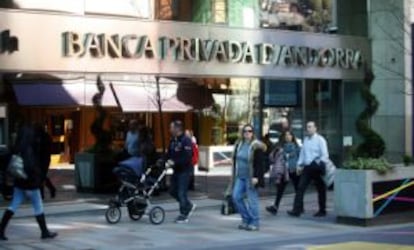Banco de Madrid ceases operations and requests a creditors’ meeting
Decision follows bank run triggered by news of watchdog probe into suspect transactions

An interim team appointed by the Bank of Spain to manage Banco de Madrid has decided to cease all operations and request a meeting of creditors, according to the industry watchdog.
The decision comes less than a week after the lender’s entire board of directors walked out as a result of an incipient investigation into suspicious transactions, leading to a run on the bank.
This Bank of Spain probe was in turn triggered by the US authorities’ actions against Banco Madrid’s parent company, Banca Privada d’Andorra (BPA), for suspected money-laundering activities.
“This decision is caused by Banco de Madrid’s significant financial deterioration as a result of major fund withdrawals by clients and by recent events that have affected its ability to meet its obligations in a timely manner,” said sources at Spain’s central bank.
By filing for a creditors’ meeting, deposit holders receive the same legal status as Banco de Madrid’s other creditors. Clients’ deposits are guaranteed up to €100,000 per account holder by the industry-funded Deposit Guarantee Fund.
Meanwhile, the police operation against managers at parent company BPA, in the Pyrenean principality of Andorra, remains open. Prosecutors have ordered two more managers arrested after the bank’s CEO, Joan Pau Miquel Prats, was sent to preventive prison on Friday.
On Monday, the government of Andorra decided to place a €2,500 limit on withdrawals at BPA, despite assurances issued on Friday by the Andorra National Finance Institute (INAF) that things would go back to normal early this week. The announcement caused lines of up to an hour in front of BPA’s offices in Andorra la Vella.

In contrast, no clients were in sight outside Banco de Madrid’s headquarters in the capital’s Plaza de Colón at noon on Monday. The offices remained closed and two signs hung on the front door: one warning clients that nobody would be in the office on Monday, and providing a telephone number to call with queries (902 42 33 33); the other sign, stuck on the glass, was a statement by the Bank of Spain announcing the decision to cease all operations at the BPA affiliate.
A police squad showed up at the bank at 1.44pm, and two officers asked to be allowed inside the building, Ignacio Fariza reports. These were finally let in through a side door by security personnel, and left the premises again seven minutes later.
The chain of events was triggered on Tuesday of last week, when the US Treasury’s anti-money-laundering unit, the Financial Crimes Enforcement Network (FinCEN), announced that BPA was “a primary money-laundering concern” and that high-level officials there allegedly helped Russian, Chinese and Venezuelan clients channel money from their criminal activities.
BPA entered the Spanish market after purchasing Banco de Madrid from Kutxabank in 2011 for €100 million.
The profile of a typical Banco de Madrid client is a high-earner with savings of over €500,000 who likes to invest in funds. Banco de Madrid controls 88 SICAVs – public limited companies that invest in financial assets and benefits from generous tax rates – with €856 million of funds under management at the close of 2014.
Until the US Treasury got in its way last week, the lender had plans to grow 33 percent in the next few months, and had hired 20 new executives just a few weeks ago.
Tu suscripción se está usando en otro dispositivo
¿Quieres añadir otro usuario a tu suscripción?
Si continúas leyendo en este dispositivo, no se podrá leer en el otro.
FlechaTu suscripción se está usando en otro dispositivo y solo puedes acceder a EL PAÍS desde un dispositivo a la vez.
Si quieres compartir tu cuenta, cambia tu suscripción a la modalidad Premium, así podrás añadir otro usuario. Cada uno accederá con su propia cuenta de email, lo que os permitirá personalizar vuestra experiencia en EL PAÍS.
¿Tienes una suscripción de empresa? Accede aquí para contratar más cuentas.
En el caso de no saber quién está usando tu cuenta, te recomendamos cambiar tu contraseña aquí.
Si decides continuar compartiendo tu cuenta, este mensaje se mostrará en tu dispositivo y en el de la otra persona que está usando tu cuenta de forma indefinida, afectando a tu experiencia de lectura. Puedes consultar aquí los términos y condiciones de la suscripción digital.
Últimas noticias
The complicated life of Francesca Albanese: A rising figure in Italy but barred from every bank by Trump’s sanctions
Half of Scotland is in the hands of 420 property owners
Reinhard Genzel, Nobel laureate in physics: ‘One-minute videos will never give you the truth’
Pinochet’s victims grapple with José Antonio Kast’s rise in Chile
Most viewed
- Pablo Escobar’s hippos: A serious environmental problem, 40 years on
- Why we lost the habit of sleeping in two segments and how that changed our sense of time
- Charles Dubouloz, mountaineering star, retires at 36 with a farewell tour inspired by Walter Bonatti
- Trump’s obsession with putting his name on everything is unprecedented in the United States
- The Florida Keys tourist paradise is besieged by immigration agents: ‘We’ve never seen anything like this’








































